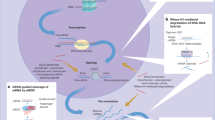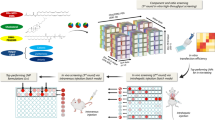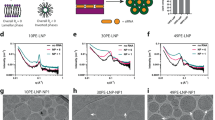Abstract
We adopted a rational approach to design cationic lipids for use in formulations to deliver small interfering RNA (siRNA). Starting with the ionizable cationic lipid 1,2-dilinoleyloxy-3-dimethylaminopropane (DLinDMA), a key lipid component of stable nucleic acid lipid particles (SNALP) as a benchmark, we used the proposed in vivo mechanism of action of ionizable cationic lipids to guide the design of DLinDMA-based lipids with superior delivery capacity. The best-performing lipid recovered after screening (DLin-KC2-DMA) was formulated and characterized in SNALP and demonstrated to have in vivo activity at siRNA doses as low as 0.01 mg/kg in rodents and 0.1 mg/kg in nonhuman primates. To our knowledge, this represents a substantial improvement over previous reports of in vivo endogenous hepatic gene silencing.
This is a preview of subscription content, access via your institution
Access options
Subscribe to this journal
Receive 12 print issues and online access
$209.00 per year
only $17.42 per issue
Buy this article
- Purchase on Springer Link
- Instant access to full article PDF
Prices may be subject to local taxes which are calculated during checkout



Similar content being viewed by others
References
de Fougerolles, A.R. Delivery vehicles for small interfering RNA in vivo. Hum. Gene Ther. 19, 125–132 (2008).
Whitehead, K.A., Langer, R. & Anderson, D.G. Knocking down barriers: advances in siRNA delivery. Nat. Rev. Drug Discov. 8, 129–138 (2009).
Judge, A.D. et al. Confirming the RNAi-mediated mechanism of action of siRNA-based cancer therapeutics in mice. J. Clin. Invest. 119, 661–673 (2009).
Judge, A.D. et al. Sequence-dependent stimulation of the mammalian innate immune response by synthetic siRNA. Nat. Biotechnol. 23, 457–462 (2005).
Morrissey, D.V. et al. Potent and persistent in vivo anti-HBV activity of chemically modified siRNAs. Nat. Biotechnol. 23, 1002–1007 (2005).
Zimmermann, T.S. et al. RNAi-mediated gene silencing in non-human primates. Nature 441, 111–114 (2006).
Akinc, A. et al. A combinatorial library of lipid-like materials for delivery of RNAi therapeutics. Nat. Biotechnol. 26, 561–569 (2008).
Frank-Kamenetsky, M. et al. Therapeutic RNAi targeting PCSK9 acutely lowers plasma cholesterol in rodents and LDL cholesterol in nonhuman primates. Proc. Natl. Acad. Sci. USA 105, 11915–11920 (2008).
Hafez, I.M., Maurer, N. & Cullis, P.R. On the mechanism whereby cationic lipids promote intracellular delivery of polynucleic acids. Gene Ther. 8, 1188–1196 (2001).
Xu, Y. & Szoka, F.C. Jr. Mechanism of DNA release from cationic liposome/DNA complexes used in cell transfection. Biochemistry 35, 5616–5623 (1996).
Zelphati, O. & Szoka, F.C. Jr. Mechanism of oligonucleotide release from cationic liposomes. Proc. Natl. Acad. Sci. USA 93, 11493–11498 (1996).
Torchilin, V.P. Recent approaches to intracellular delivery of drugs and DNA and organelle targeting. Annu. Rev. Biomed. Eng. 8, 343–375 (2006).
Semple, S.C. et al. Efficient encapsulation of antisense oligonucleotides in lipid vesicles using ionizable aminolipids: formation of novel small multilamellar vesicle structures. Biochim. Biophys. Acta 1510, 152–166 (2001).
Maurer, N. et al. Spontaneous entrapment of polynucleotides upon electrostatic interaction with ethanol-destabilized cationic liposomes. Biophys. J. 80, 2310–2326 (2001).
Heyes, J., Palmer, L., Bremner, K. & Maclachlan, I. Cationic lipid saturation influences intracellular delivery of encapsulated nucleic acids. J. Control. Release 107, 276–287 (2005).
Semple, S.C., Chonn, A. & Cullis, P.R. Interactions of liposomes and lipid-based carrier systems with blood proteins: Relation to clearance behaviour in vivo. Adv. Drug Deliv. Rev. 32, 3–17 (1998).
Bailey, A.L. & Cullis, P.R. Modulation of membrane fusion by asymmetric transbilayer distributions of amino lipids. Biochemistry 33, 12573–12580 (1994).
Cullis, P.R. & de Kruijff, B. The polymorphic phase behaviour of phosphatidylethanolamines of natural and synthetic origin. A 31P NMR study. Biochim. Biophys. Acta 513, 31–42 (1978).
Epand, R.M., Robinson, K.S., Andrews, M.E. & Epand, R.F. Dependence of the bilayer to hexagonal phase transition on amphiphile chain length. Biochemistry 28, 9398–9402 (1989).
Sekijima, Y., Kelly, J.W. & Ikeda, S. Pathogenesis of and therapeutic strategies to ameliorate the transthyretin amyloidoses. Curr. Pharm. Des. 14, 3219–3230 (2008).
Cullis, P.R., Hope, M.J. & Tilcock, C.P. Lipid polymorphism and the roles of lipids in membranes. Chem. Phys. Lipids 40, 127–144 (1986).
Heyes, J., Hall, K., Tailor, V., Lenz, R. & MacLachlan, I. Synthesis and characterization of novel poly(ethylene glycol)-lipid conjugates suitable for use in drug delivery. J. Control. Release 112, 280–290 (2006).
Jeffs, L.B. et al. A scalable, extrusion-free method for efficient liposomal encapsulation of plasmid DNA. Pharm. Res. 22, 362–372 (2005).
Acknowledgements
The authors thank K. McClintock for assistance with animal studies. The authors also thank the Centre for Drug Research and Development at the University of British Columbia for use of the NMR facilities and M. Heller for his expert assistance in setting up the 31P-NMR experiments.
Author information
Authors and Affiliations
Contributions
J.C., M.A.C., P.R.C., T.D.M., M.J.H. and K.F.W. designed and advised on novel lipids. J.C., K.F.W. and M.S. synthesized novel lipids. M.J.H., T.D.M., J.C., K.F.W., M.M., K.G.R., M.A.M., M.T. and M.J. analyzed and interpreted lipid data. T.D.M., M.J.H. and M.A.T. co-directed novel lipid synthesis and screening program. S.C.S. designed and directed rodent in vivo studies. S.C.S., S.K.K., B.L.M., K.L., M.L.E., M.K., A.P.S., Y.K.T., S.A.B., W.L.C., M.J.W. and E.J.C. generated rodent in vivo data, including Factor VII and tolerability analyses. L.N., V.K., T.B., R.A., Q.C. and D.W.Y.S. developed novel siRNAs targeting TTR. R.A. and A.A. designed and directed NHP in vivo studies. S.C.S., S.K.K., A.A., B.L.M., I.M., A.P.S., Y.K.T., R.A., T.B., D.W. Y. S., S.A.B., J.Q., J.R.D. and A.d.F. analyzed and interpreted in vivo data. B.L.M., K.L., A.P.S., S.K.K., S.C.S. and E.J.C. generated and characterized preformed vesicle formulations with novel lipids. D.S. and C.K.C. developed methods and designed and conducted HPLC lipid analyses of preformed vesicle formulations. E.Y. and L.B.J. prepared SNALP formulations. P.R.C. directed biophysical studies and advised on methods. A.P.S., I.M.H., S.D. and K.W. performed biophysical characterization studies (pKa, NMR, differential scanning calorimetric) of novel lipids and formulations. M.J.H., P.R.C., T.D.M., A.P.S., I.M.H. and K.F.W. analyzed biophysical data. S.C.S., M.J.H., A.A. and P.R.C. co-wrote the manuscript. T.D.M., M.M., M.A.M., M.A.T. and A.D.F. reviewed and edited the manuscript. S.C.S., M.J.H., A.A., P.R.C., I.M. and A.D.F. were responsible for approval of the final draft.
Corresponding authors
Ethics declarations
Competing interests
Authors are employees of Alnylam, Tekmira, or Alcana or receive funding from Alnylam.
Supplementary information
Supplementary Text and Figures
Supplementary Fig. 1, Supplementary Tables 1–4 and Supplementary Syntheses 1 and 2 (PDF 345 kb)
Rights and permissions
About this article
Cite this article
Semple, S., Akinc, A., Chen, J. et al. Rational design of cationic lipids for siRNA delivery. Nat Biotechnol 28, 172–176 (2010). https://doi.org/10.1038/nbt.1602
Received:
Accepted:
Published:
Issue Date:
DOI: https://doi.org/10.1038/nbt.1602
This article is cited by
-
RNA interference in the era of nucleic acid therapeutics
Nature Biotechnology (2024)
-
In situ combinatorial synthesis of degradable branched lipidoids for systemic delivery of mRNA therapeutics and gene editors
Nature Communications (2024)
-
Advances in functional lipid nanoparticles: from drug delivery platforms to clinical applications
3 Biotech (2024)
-
A potential paradigm in CRISPR/Cas systems delivery: at the crossroad of microalgal gene editing and algal-mediated nanoparticles
Journal of Nanobiotechnology (2023)
-
New trends in brain tumor immunity with the opportunities of lymph nodes targeted drug delivery
Journal of Nanobiotechnology (2023)



